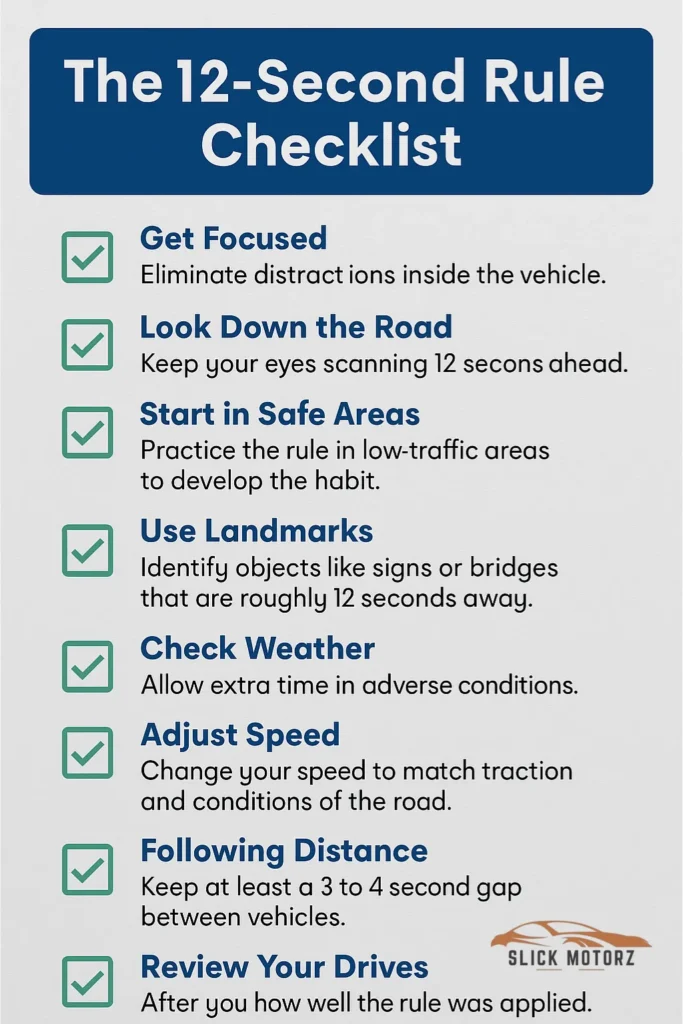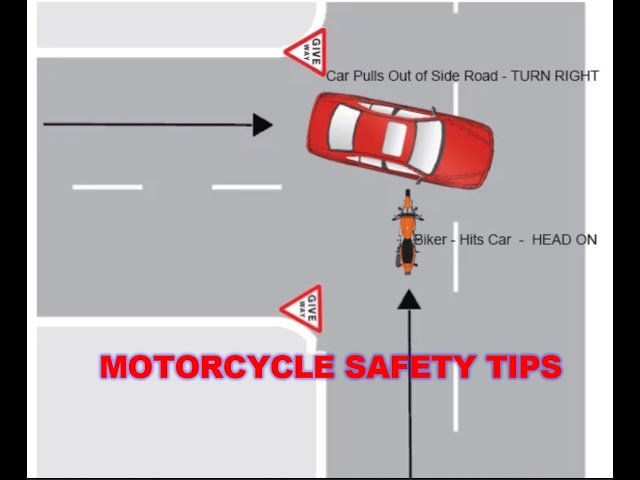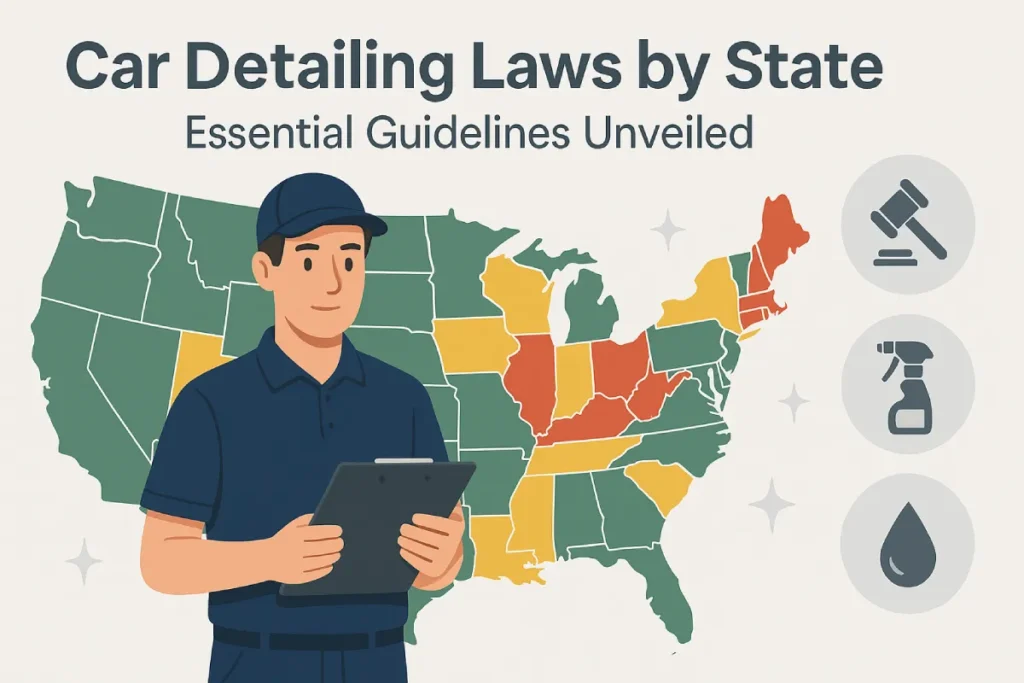Have you ever wondered how some drivers seem to navigate traffic with ease, while others are constantly caught off guard? The secret might be something as simple as the 12-Second Rule.
Whether you’re an experienced driver or just starting out, mastering this rule could be your key to safer, more confident driving. By learning to anticipate hazards before they happen, you give yourself enough time to react calmly and effectively. Imagine reducing stress on the road, avoiding last-minute braking, and enjoying smoother journeys.
Intrigued? Let’s learn what the 12-Second Rule for cars is all about and how it can transform your driving experience.
The Basics Of The 12-second Rule
Driving safely requires awareness of surroundings and anticipating potential hazards. The 12-second rule is a vital technique to enhance road safety. It helps drivers maintain a safe distance by predicting the flow of traffic.
Imagine you’re driving on a busy road. The 12-second rule advises you to look 12 seconds ahead. This means you should observe what’s happening far in front of your car.
This technique allows you to anticipate changes in traffic. You can see brake lights, lane changes, or any obstacles. By doing so, you have more time to react.
Why 12 Seconds Matter
Reacting quickly can prevent accidents. The 12-second rule provides a buffer time. It helps you slow down or change lanes safely.
Looking far ahead reduces sudden surprises. It increases your decision-making time. This leads to smoother driving experiences.
Applying The Rule In Different Conditions
The 12-second rule adapts to various driving conditions. On highways, it helps with high-speed travel. In city traffic, it aids in navigating busy streets.
During night driving, it enhances visibility. By scanning the road ahead, you can spot any potential hazards. This is especially useful during bad weather conditions.

Origins Of The Rule
The 12-Second Rule for cars is a safety guideline. It encourages drivers to maintain a safe distance. This ensures they have enough time to react. The origins of this rule date back decades. It emerged from studies on road safety.
Experts noticed a pattern in accident reports. Drivers often lacked time to respond to sudden changes. This led to the idea of anticipating the road ahead. The 12-Second Rule was born from this insight.
Understanding Traffic Flow
Researchers analyzed traffic flow and driver behavior. They found common patterns in traffic accidents. Most drivers focused on the vehicle directly ahead. This limited their reaction time to unexpected events.
The 12-Second Rule shifts focus further ahead. It encourages drivers to anticipate changes in traffic. This increases the time available to react. It enhances overall road safety.
Influence Of Road Safety Studies
Road safety studies played a key role in developing the rule. These studies highlighted the importance of reaction time. They emphasized the need for proactive driving.
The 12-Second Rule emerged as a practical solution. It provided a clear guideline for maintaining awareness. The rule’s simplicity made it easy to adopt by drivers.
Adoption By Driving Schools
Driving schools quickly adopted the 12-Second Rule. They recognized its value in teaching safe driving habits. Instructors incorporated it into their curriculum.
Students learned to scan the road ahead. They practiced maintaining a broader view of their surroundings. This prepared them for real-world driving situations.
How The Rule Enhances Safety
The 12-Second Rule is a simple driving tip. It helps drivers maintain safety on the road. This rule encourages anticipating potential hazards. Drivers stay alert and aware of their surroundings. Understanding this rule can greatly reduce accidents.
Following the 12-Second Rule means scanning the road ahead. Look as far ahead as you can see. This helps in identifying obstacles early. It allows drivers to prepare for sudden changes. Whether it’s a car braking or debris on the road.
This proactive approach reduces reaction time. With more time, decisions are clearer. Drivers can adjust their speed or change lanes safely. Anticipating problems improves overall road safety.
Improved Situational Awareness
The rule fosters situational awareness. Drivers become more conscious of their environment. They observe traffic patterns and road conditions. Increased awareness often leads to safer driving habits.
Reduced Stress Levels
Applying the rule can reduce stress. Knowing potential hazards minimizes surprise. Drivers feel more in control. Lower stress levels contribute to a safer driving experience.
Prevention Of Collisions
Anticipating the movement of other vehicles is key. Drivers using the rule can prevent collisions. Early prediction allows for safe maneuvers. This proactive behavior keeps everyone safer.
Applying The Rule In Real Life
Understanding the 12-Second Rule can transform your driving experience. This rule helps drivers anticipate changes on the road. It advises scanning the road ahead for 12 seconds. By doing so, drivers can spot potential hazards early.
Applying this rule in real life means staying alert. It requires observing the road, traffic signals, and other vehicles. This practice enhances safety and reduces risks. Below are ways to apply the 12-Second Rule in various driving scenarios.
Urban Driving Scenarios
City streets are often busy and unpredictable. Pedestrians crossing or sudden stops are common. The 12-Second Rule helps anticipate such events. Scan the road ahead and adjust your speed accordingly. Look for signals, traffic lights, and crowded areas. This foresight reduces the chances of accidents.
In urban areas, drivers face many distractions. Stay focused on the road and surroundings. This rule ensures you have enough time to react. It helps in making decisions like changing lanes safely. By scanning ahead, you spot issues before they become problems.
Highway Driving Applications
Highways offer different challenges than city roads. Vehicles move faster, and lanes are wider. The 12-Second Rule is crucial here. It allows drivers to anticipate lane changes and exits. By looking ahead, you avoid abrupt maneuvers.
On highways, spotting potential hazards early is vital. This rule helps maintain safe distances from other vehicles. It also assists in identifying slow-moving traffic. By applying this rule, drivers ensure smoother and safer journeys.
Common Misconceptions
The 12-second rule is a simple driving technique. It helps drivers anticipate potential hazards on the road. Many drivers misunderstand its purpose or application. These misconceptions can lead to improper usage. Knowing these misunderstandings can improve your driving experience.
Misconception: It’s Only For New Drivers
Some believe the 12-second rule is only for beginners. In reality, this rule is vital for all drivers. Experienced drivers benefit from this rule too. It helps them maintain safety and awareness on the road.
Misconception: It’s Only Used On Highways
Many think the 12-second rule applies only to highways. This rule is useful on all roads. It ensures safety in urban and rural settings. Always keep a 12-second sight distance, regardless of location.
Misconception: It’s A Legal Requirement
Some drivers think this rule is a legal mandate. The 12-second rule is a safety guideline, not law. It’s a recommendation to enhance driving safety. Using it can help avoid potential accidents.
Misconception: It’s Difficult To Implement
Drivers sometimes find this rule complicated. In truth, it’s simple and practical. Just focus on a point 12 seconds ahead. Adjust speed to maintain the distance.
Misconception: It’s Only For Bad Weather
The rule is often associated with bad weather. It’s crucial in all weather conditions. Good weather doesn’t remove road hazards. Staying alert remains important every time you drive.

Credit: www.youtube.com
Benefits Of The 12-second Rule
Have you ever felt the sudden adrenaline rush when a car stops abruptly in front of you? The 12-Second Rule can help avoid these heart-pounding moments. By maintaining a lookout for what’s happening 12 seconds ahead of your vehicle, you create a buffer of safety. This concept offers several benefits, making your driving experience not just safer but more enjoyable.
Improved Reaction Time
Picture this: you’re cruising down the highway, and suddenly a deer darts across the road. With the 12-Second Rule, you have enough time to react calmly and effectively. This rule sharpens your reflexes, allowing you to respond to unexpected events before they become emergencies.
Think of your last drive. Did you spot the brake lights of the car ahead, or were you caught off guard? The 12-Second Rule gives you the edge by letting you anticipate and prepare for such situations. It’s like having a sixth sense, but one you can develop with practice.
Better Situational Awareness
When you focus on what’s happening 12 seconds ahead, you enhance your situational awareness. You become aware of potential hazards, traffic patterns, and changing road conditions well in advance. This awareness reduces stress and allows you to make informed decisions.
Consider your everyday commute. Have you ever missed an exit because you weren’t paying attention? The 12-Second Rule helps you stay alert, ensuring that you’re always in control. It’s not just about reacting to immediate threats but anticipating them.
Why not try it on your next drive? Notice how much more relaxed and confident you feel. You might find that your journey becomes smoother and less taxing on your nerves.
So, are you ready to embrace the 12-Second Rule? It’s not just a technique; it’s a mindset shift that can transform your driving experience. Take control of your road adventures and see the difference it makes.
Comparing With Other Driving Techniques
The 12-Second Rule helps drivers anticipate potential hazards, enhancing road safety. It encourages observing the road ahead for 12 seconds, unlike other techniques focused on immediate surroundings. This proactive approach minimizes sudden braking and swerving, offering smoother and safer driving experiences.
When you’re on the road, different driving techniques can make a huge difference in your safety and comfort. One such technique is the 12-Second Rule, which encourages drivers to look 12 seconds ahead of their vehicle to anticipate potential hazards. But how does this rule stack up against other popular driving techniques? Let’s dive into a comparison, focusing on the Two-Second Rule and Defensive Driving.
Two-second Rule
The Two-Second Rule is all about maintaining a safe following distance between your car and the vehicle in front. This simple rule helps ensure you have enough time to react if the car ahead suddenly stops. Picture yourself driving on a busy highway. The car in front of you brakes unexpectedly. With the Two-Second Rule, you have just enough space to avoid a collision. By glancing at a landmark as the car ahead passes it, and counting “one thousand one, one thousand two,” you can gauge if you’re following safely. Both the 12-Second and Two-Second Rules emphasize looking ahead, but they differ in focus. While the 12-Second Rule prepares you for distant hazards, the Two-Second Rule is about immediate safety. Which rule do you rely on more during rush hour?
Defensive Driving
Defensive driving is a broader technique that involves anticipating and responding to the actions of other drivers. It’s about being prepared for anything, from sudden lane changes to erratic drivers. Imagine you’re driving through a busy intersection. A car swerves unexpectedly into your lane. Defensive driving skills can help you maneuver safely, avoiding the unexpected. This technique is more comprehensive than the 12-Second Rule, as it encompasses a range of strategies like maintaining awareness, predicting others’ actions, and keeping a safe distance. While the 12-Second Rule aids in long-term vision, defensive driving focuses on immediate reactions and overall awareness. How often do you find yourself relying on defensive driving tactics to navigate tricky situations? In comparing these techniques, each offers unique benefits. The key is integrating them to enhance your driving experience. Are you using the right mix for safer travels?

Credit: altrainsurance.com
Tips For Practicing The Rule
Stay safe on the road by practicing the 12-second rule for cars. Keep a 12-second distance from the car ahead. This gives you time to react to sudden stops or changes.
When you’re behind the wheel, staying safe on the road is your top priority. The 12-second rule is a simple yet effective tool that can significantly enhance your driving safety. This rule suggests you should always look 12 seconds ahead of your current position on the road to anticipate any potential hazards. But how can you consistently practice this rule to make it second nature? Here are some practical tips to help you implement the 12-second rule effectively every time you drive.
Stay Focused On The Road
Distractions can ruin your ability to anticipate danger. Keep your eyes on the road and avoid looking down at your phone or fiddling with the radio. If you find yourself getting distracted, practice bringing your attention back to the road ahead.
Use Landmarks As Reference Points
Identify a landmark that’s approximately 12 seconds away from your vehicle. It could be a street sign, a tree, or a building. As you drive, maintain focus on reaching that point. This technique helps you gauge distances more accurately.
Practice In Low-traffic Areas
If you’re new to the 12-second rule, start practicing in areas with less traffic. This gives you the space and time to develop your skills without feeling overwhelmed. As you gain confidence, you can gradually apply it in busier environments.
Adjust Your Speed Accordingly
The faster you drive, the further ahead you need to look. Keep this in mind, especially on highways or open roads. Adjust your speed to ensure you’re giving yourself enough time to react to potential obstacles.
Be Mindful Of Weather Conditions
Poor weather can affect visibility and reaction time. In such conditions, extend your 12-second rule to account for these challenges. Allow extra space and time to ensure you can respond to unexpected situations.
Reflect On Your Driving Experience
After your drive, take a moment to reflect on how well you practiced the 12-second rule. Did you anticipate any hazards more effectively? Were there moments you could improve? Reflecting on your experience helps reinforce the habit. Engaging with the 12-second rule can transform your driving experience. Have you ever noticed how a slight change in focus can alter your perception of the road? By integrating these tips into your routine, you not only enhance your safety but also contribute to a smoother, more enjoyable journey. So, the next time you hit the road, challenge yourself to see 12 seconds ahead. Your future self—and your fellow drivers—will thank you.
Frequently Asked Questions
What Is The 12-second Rule In Driving?
The 12-second rule in driving suggests maintaining a 12-second distance from the vehicle ahead. This ensures enough reaction time for unexpected situations, enhancing safety. By looking 12 seconds ahead, drivers anticipate potential hazards and make safer driving decisions.
What Is The 12-to-15-second rule?
The 12 to 15 second rule suggests keeping viewer attention by changing visuals or introducing new content every 12 to 15 seconds. This technique enhances engagement and prevents viewers from losing interest, making it crucial for effective video marketing and presentations.
What Does It Mean To Look 12 Seconds Ahead?
Looking 12 seconds ahead means anticipating future events or changes. This foresight helps in making proactive decisions and avoiding potential obstacles, especially in driving or strategic planning. It enhances safety and efficiency by predicting outcomes and preparing for them.
Why Should You Look Ahead 12-15 Seconds While Driving?
Looking 12-15 seconds ahead helps anticipate hazards and make safer driving decisions. It ensures smoother traffic flow and reduces sudden stops, enhancing road safety. By maintaining awareness, drivers can adjust speed and position, avoiding potential accidents. This proactive approach enhances driving efficiency and reduces stress on the road.
Conclusion
The 12-second rule is about staying safe on the road. It helps drivers keep a safe distance from other cars. This rule means looking ahead 12 seconds in traffic. Doing so allows more time to react. Avoid accidents. Stay calm.
Practice this rule every time you drive. It becomes a habit. Remember, safety is key. Help others by sharing this rule. Everyone benefits from safer roads. So, keep this tip in mind. Drive smart. Stay safe.
If you’re serious about car care, don’t miss our guide on Best Car Detailing Product Recommendation.















